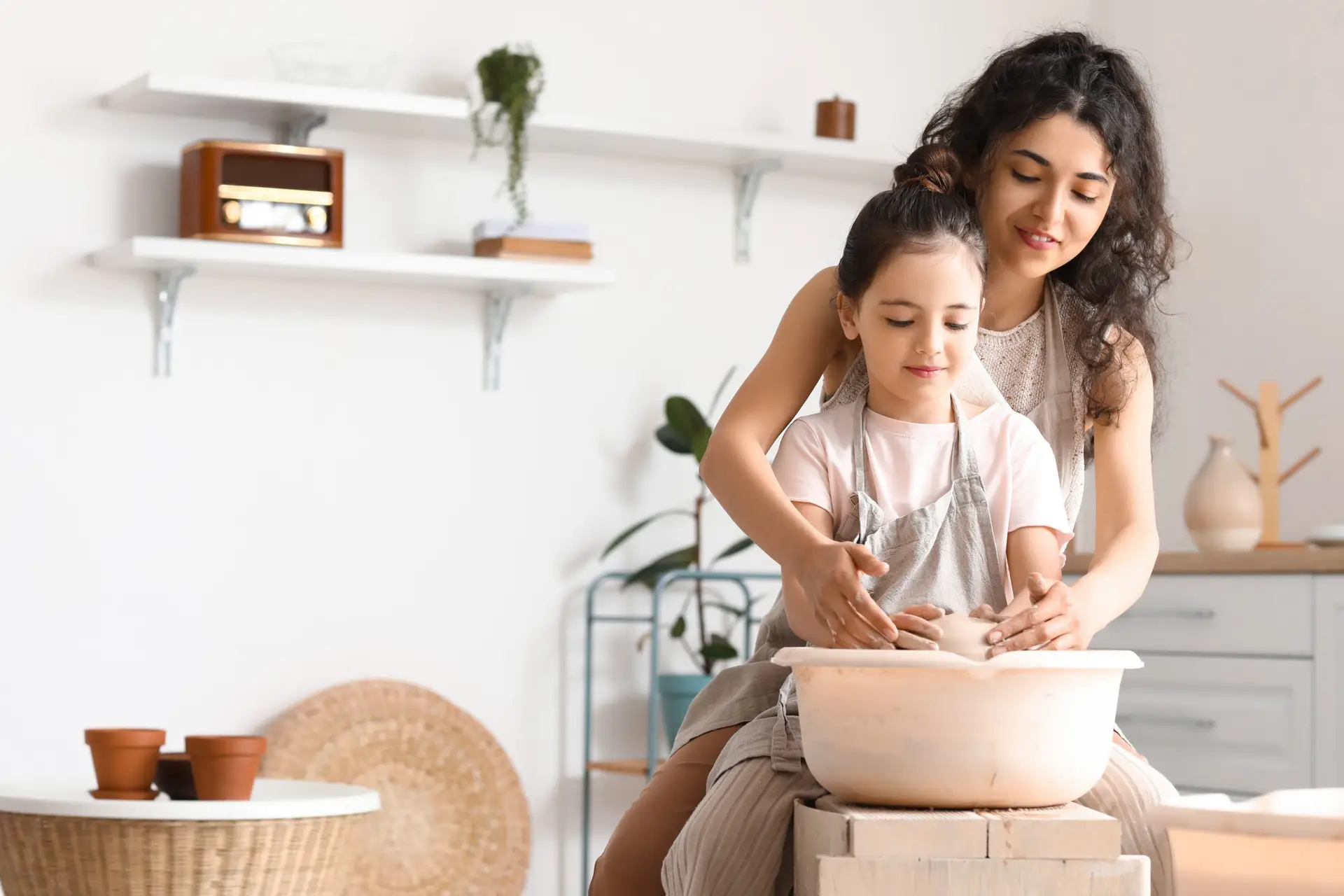A few months ago, a friend and I attended a small pottery class to celebrate his birthday. We had never tried ceramics before, and were excited at the prospect of making something creative that we would really use. As we entered the studio, the teacher gave us a clay-stained apron and planted us in front of a pottery wheel. We each received a hunk of clay and away we went.
You guys, pottery is hard. By the end of the class, our hands and aprons were caked in red clay and the bucket of broken or scrapped projects was full. Despite our many missteps (and there were many), we were pretty successful in the end! We made two pieces each: a mug and a bowl. A few weeks later we returned to the studio and picked up our freshly-fired masterpieces. I still use my creations to this day—my keys live in the bowl and the mug houses hot tea.
Adults aren’t the only ones who can make ceramics—kids can as well. Messing around and throwing a pot or two gets kids working with their hands and flexing their creative muscles. Encouraging kids to explore their creativity inspires out-of-the-box thinking and helps children develop problem-solving skills. Pottery is about more than just creativity, however, so let’s look at a few reasons why your child may benefit from practicing pottery for kids.
Pottery Hones Fine Motor Skills
Hands are your child’s main tool when making ceramics. They need their palms to round out the clay and start the throwing process while their fingers mold the wet material into shape. These movements, and most other hand motions, utilize fine motor skills.
Fine motor skills are what give children (and adults!) the ability to make dexterous movements and manipulate objects with their hands, fingers, and wrists. Working with clay requires mastery over these subtle movements, in addition to hand-eye coordination. When your kids are practicing their pottery abilities by making sculptures or teacups, they’re also honing their fine motor skills. This seemingly simple developmental practice will help them in other fields like writing, typing, and using a phone (like a kid-friendly Troomi phone, perhaps).
Throwing a Pot Requires Forethought
It’s common for kids to struggle when tasked with planning ahead. After all, planning is a pretty complex skill that requires a lot of practice to develop. That’s where pottery comes in.
One of the most important parts of making ceramics is planning. Developing a plan of attack before you sit down at the wheel makes the throwing process easier and much more enjoyable. When kids are introduced to the world of pottery, they are encouraged to craft a mental image of the piece they want to shape before they work with the clay. This necessary forethought reminds kids of the importance of planning ahead, and inspires some pretty cool creations.
Pottery Teaches Kids to Learn from Mistakes
While it’s important to plan ahead, it’s also important to know that the pottery process may not always go according to plan. This is a lesson that kids will learn pretty quickly when they start playing with ceramics. When my friend and I took that pottery class, we had three or four failed attempts for every success. It was frustrating, but we took a new lesson from each mistake and got better as we kept working.
Letting kids fail is one of the best ways to help them grow. Failure teaches kids responsibility, allows them to try, encourages them to take risks, and provides them with coping skills, as Troomi writer Tiffany Tolman attests. It may be hard watching your child fail in the moment, but remind them to persevere. You know what they say: practice makes perfect.
Creating Something Functional Boosts a Child’s Self-Esteem
One of the main reasons I’m fascinated by ceramics is because the creations you make on the wheel are more than works of art: they serve a function. Unlike oil paintings that gather dust on the wall or short stories that live in a thick tome, homemade pots and plates are often used in everyday life.
When a child sees their creations used throughout the home, it gives them a sense of purpose that inspires higher levels of self-esteem. So when your kiddo comes home from their first pottery class with something that looks more like a crumpled up newspaper than a plate, don’t hide it away in a cupboard—put it on a pedestal of honor so that everyone can see it. Of course, don’t forget to ask for your child’s permission first.
Working with Clay Is Meditative
Children live busy lives. They spend all day learning in the classroom, then come home only to work on homework, be picky about dinner, and play with friends and family before an early bedtime. With such a packed schedule, it’s nearly impossible for kids to calm their chaotic minds and focus on one activity.
It’s no secret that pottery is therapeutic and relaxing. There’s something so meditative about getting in the zone and feeling wet clay slide beneath your hands. Pottery enables kids to slow down and have some alone time. As kids spend more time with the clay, they’ll start to develop improved focus and increased optimism, in addition to lower stress levels.
Throwing a pot isn’t the only way to meditate, and smartphones from Troomi Wireless make it easy for kids to get their zen on. Our kid-friendly, parent-approved smart devices feature a plethora of KidSmartⓇ apps like Headspace and Ambience that encourage kids to get in touch with their inner mindfulness coach. Click here to learn a little bit more about how Troomi phones inspire kids to slow down and develop a healthy relationship with technology.
Encourage Your Kids to Get Creative
As you can see, not only does pottery encourage kids to explore their creativity, but the practice also helps them develop skills that will benefit their lives outside the studio. Who knows: if your kiddo loves pottery, you may never need to buy another pot or dish again. Sounds like a pretty sweet deal to me!


